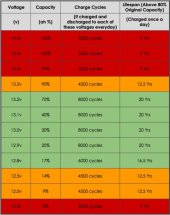Hi Folks
I live in a part of the world where the sun doesn't really shine much. It's extremely inconsistent to say the least.
I've been using solar power for the past 2 years. My most recent setup from last summer is 6 x AGM batteries, 3 x epsolar controllers, and 12 Renogy 120W panels all in parallel (12v system).
Obviously, the inconsistent sunshine is not good for my agm batteries as they like to be fully charged always. I've been using a grid charger to keep my batteries topped up during periods of low sunshine. As such, my main issue is that on the days I have good sun, my batteries are charged too much to take the max current, and on the days I have little sun, my SOC drops low.
I've ordered a lifepo4 battery to replace my agms. My question is, do lifepo4 suffer if left at a low state of charge for long periods? Eg. Over the course of a week, 4-5 days hovering between 10% and 50%, then perhaps one or two days getting enough sun to get fully charged, before dropping low again.
It would be really nice if lifepo4 could handle my inconsistent charging patterns and not have to worry, but that seems like a miracle. Surely there must be some negative to lifepo4 (apart from high upfront cost)?
I do get enough sunshine to cover my loads, just not at the right time!!
Thanks!
I live in a part of the world where the sun doesn't really shine much. It's extremely inconsistent to say the least.
I've been using solar power for the past 2 years. My most recent setup from last summer is 6 x AGM batteries, 3 x epsolar controllers, and 12 Renogy 120W panels all in parallel (12v system).
Obviously, the inconsistent sunshine is not good for my agm batteries as they like to be fully charged always. I've been using a grid charger to keep my batteries topped up during periods of low sunshine. As such, my main issue is that on the days I have good sun, my batteries are charged too much to take the max current, and on the days I have little sun, my SOC drops low.
I've ordered a lifepo4 battery to replace my agms. My question is, do lifepo4 suffer if left at a low state of charge for long periods? Eg. Over the course of a week, 4-5 days hovering between 10% and 50%, then perhaps one or two days getting enough sun to get fully charged, before dropping low again.
It would be really nice if lifepo4 could handle my inconsistent charging patterns and not have to worry, but that seems like a miracle. Surely there must be some negative to lifepo4 (apart from high upfront cost)?
I do get enough sunshine to cover my loads, just not at the right time!!
Thanks!



